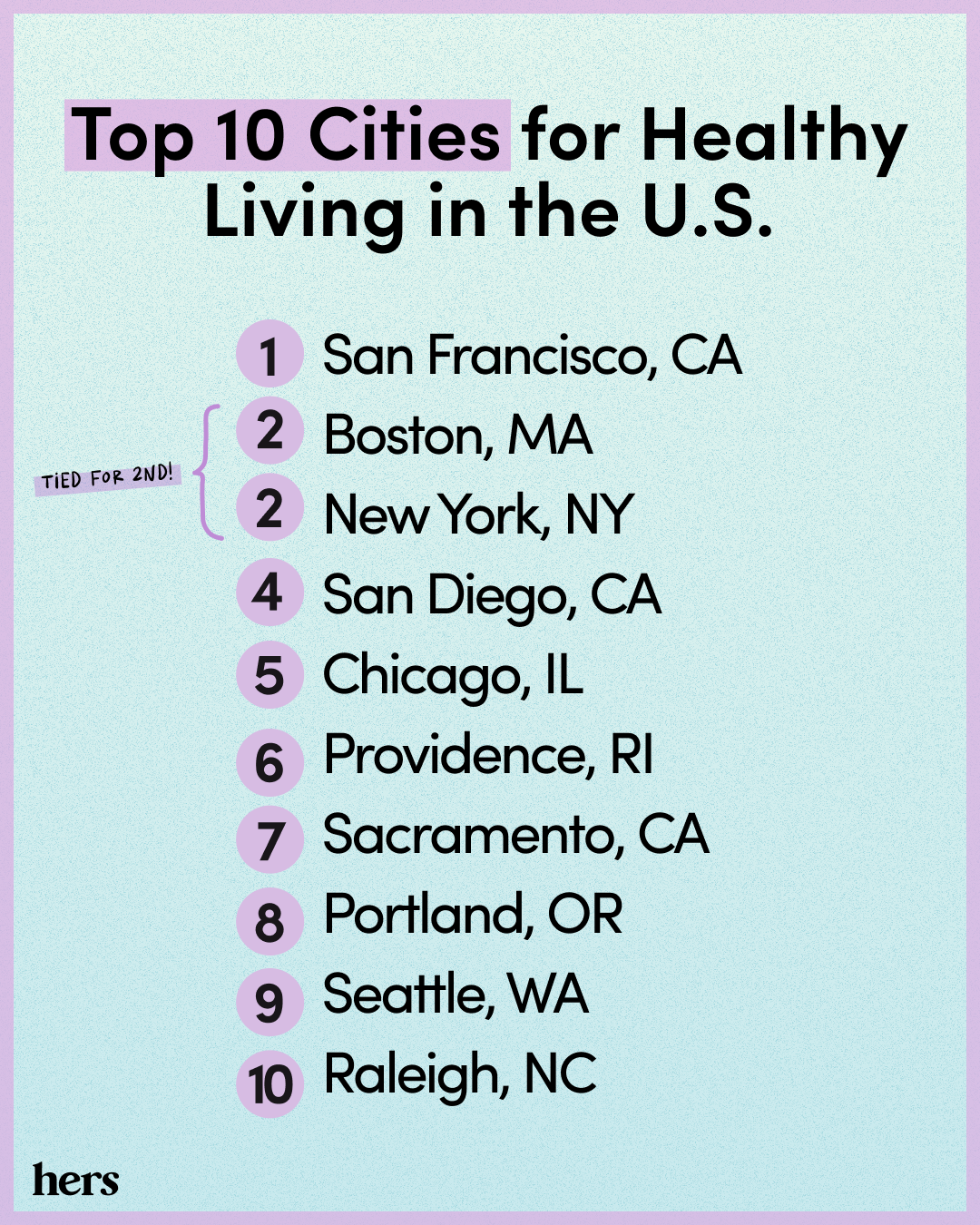Indy ranks among best cities in US for healthy living
There are so many factors that can influence healthy living and weight loss. Genetics and psychology both play a major role, but so can a person’s environment. That’s why Hers set out to rank the 50 most populous cities from best to worst according to which make it easy to live a healthy lifestyle.
We analyzed four data sets around key pillars that contribute to overall health, including nutrition, behavior, movement, and medical treatment.
We used the following data points to determine the best cities for healthy living in the U.S.:
- Concentration of grocery stores compared to the population: Access to healthy food is one factor associated with a longer life expectancy, according to a study by the American Cancer Society.
- How many people are getting enough sleep: The Office of Disease Prevention and Health Promotion reports that consistently getting too little sleep increases the risk of a number of health issues, including obesity, diabetes, heart disease, and even cancer.
- Walkability of the city: Walking on a regular basis improves a number of health outcomes, including weight loss, decreased risk of breast cancer, reduced arthritis pain, and better immunity.
- Access to psychologists and psychiatrists: Mental and physical health go hand in hand. People with depression, for instance, are at a significantly higher risk (40%) for both cardiovascular and metabolic diseases.
Ready to see how your city stacks up? Let’s jump into the results.

Hers
Key Findings
- New York City dominates when it comes to grocery stores, walkability, and mental health care access. However, it truly is the city that never sleeps: Nearly 40% of New Yorkers get less than seven hours of shuteye a night.
- West Coast cities account for half of our 10 healthiest cities. Areas that made the list include San Francisco, San Diego, Sacramento, Portland, and Seattle.
- Raleigh, North Carolina is the only Southern city to make it in the top 10 best cities for healthy living. The tech-centric city ranked particularly well for sleep, walkability, and access to psychologists and psychiatrists.
- Las Vegas ranks as the worst city for healthy living in America. The concentration of grocery stores and mental health professionals is low compared to the size of the population, and Las Vegas isn’t considered very walkable.
The Best Cities for Healthy Living in the U.S.: Trends and Insights
Before digging into the final rankings, let’s look at the breakdown of best and worst cities based on each individual category we analyzed: prevalence of grocery stores compared to the population, amount of sleep, walkability, and access to mental health professionals.
Which Cities Have the Most Grocery Stores?
Eating the right foods plays a huge role in losing weight and staying healthy. From focusing on protein-rich meals to stocking up on healthy snacks, having access to fresh, whole foods makes a big difference in your ability to plan nutritious meals. The goal is to eat real food that’s not ultra-processed, and that’s not going to happen if you don’t have a grocery store near you.
We looked at the number of grocery stores per capita in each city. Here’s what we discovered when looking at the best and worst locales in this specific category.
Most Grocery Stores Per 100K Residents
- New York-Newark-Jersey City
- New Orleans-Metairie
- Boston-Cambridge-Newton
Fewest Grocery Stores Per 100k Residents
- Oklahoma City
- Phoenix-Mesa-Chandler
- Indianapolis-Carmel-Anderson
You may expect to see large metropolitan statistical areas (MSA) like New York and Boston with a high prevalence of grocery stores. But New Orleans is more surprising since food insecurity impacts an estimated 15% of the population. Its neighbor Metairie may play a role in boosting its ranking.
Which Cities Get the Best and Worst Sleep?
According to the CDC, the recommended amount of sleep each night is at least seven hours. Quality sleep reduces the risk of a variety of diseases and contributes to weight loss. What’s even better is that getting the right amount of sleep can be an easy win for better health.
The CDC tracks the percentage of adults getting less than seven hours of sleep. So we’ve ranked the best cities for sleep as having the lowest percentage of adults sleeping less than the minimum recommended amount. The worst cities for sleep have a higher number of adults getting under seven hours of shut eye.
Cities Getting More Sleep in the U.S.
- Denver, CO
- Austin, TX
- Seattle, WA
Cities Getting the Least Amount of Sleep in the U.S.
- Detroit, MI
- Baltimore, MD
- Cincinnati, OH
What Are the Most Walkable Cities?
Walking has an incredible impact on health and is an accessible, low impact way to lose weight. You don’t need expensive equipment or a gym membership to get outside and walk. But some cities are better suited for daily walking than others.
We looked at the walkability score for each city based on their city hall location in order to find the best and worst places for getting in those daily steps to get healthy.
Most Walkable Cities in the U.S.
- Chicago, IL
- New York, NY
- Philadelphia, PA
Least Walkable Cities in the U.S.
- Virginia Beach, VA
- Columbus, OH
- Houston, TX
Larger cities like Chicago, New York, and Philadelphia have plenty of pavement to hit each day. You may be harder pressed to walk out of your office or apartment in more sprawling cities like Virginia Beach, Columbus, and Houston.
Where Is It Easiest to Find a Psychologist or Psychiatrist?
Your mental health is just as important as your physical health; and in reality, the two are inextricably linked. Most people eat to combat stress. By addressing mental health issues, like anxiety or depression, you may be able to decrease the habit of eating for mood elevation.
Cities with larger concentrations of psychologists and psychiatrists make it easier to find a mental health professional you like and get on their schedule in a timely manner.
From avoiding stress eating to managing anxiety, accessing mental health care can be just as important when it comes to healthy living as finding the right doctor for your physical needs.
Cities With the Highest Concentration of Psychologists and Psychiatrists
- Providence, RI
- New York, NY
- Baltimore, MD
Cities With the Lowest Concentration of Psychologists and Psychiatrists
- Oklahoma City, OK
- Las Vegas, NV
- Memphis, TN
The 25 Best Cities for Healthy Living in the U.S.
Based on our criteria mentioned above and methodology outlined below, these are the best cities for healthy living in the U.S.
- San Francisco, California
- Boston, Massachusetts (tied for second)
- New York, New York (tied for second)
- San Diego, California
- Chicago, Illinois
- Providence, Rhode Island
- Sacramento, California
- Portland, Oregon
- Seattle, Washington
- Raleigh, North Carolina
- Baltimore, Maryland
- Miami, Florida
- Hartford, Connecticut
- San Jose, California
- Philadelphia, Pennsylvania
- Washington, D.C.
- Los Angeles, California
- Tampa, Florida
- Buffalo, New York
- Indianapolis, Indiana
- Denver, Colorado
- Pittsburgh, Pennsylvania
- Minneapolis, Minnesota
- Milwaukee, Wisconsin
- Salt Lake City, Utah
The 25 Worst Cities for Healthy Living in the U.S.
Based on our criteria mentioned above and methodology outlined below, these are the worst cities for healthy living in the U.S.
- Las Vegas, Nevada
- Birmingham, Alabama
- Memphis, Tennessee
- Columbus, Ohio
- Phoenix, Arizona
- Kansas City, Missouri
- Oklahoma City, Oklahoma
- Orlando, Florida
- Detroit, Michigan
- Charlotte, North Carolina
- Cincinnati, Ohio
- Cleveland, Ohio
- Nashville, Tennessee
- Atlanta, Georgia
- New Orleans, Louisiana
- Houston, Texas
- St. Louis, Missouri
- Virginia Beach, Virginia
- Louisville, Kentucky
- Jacksonville, Florida
- Richmond, Virginia
- Riverside, California
- Dallas, Texas
- San Antonio, Texas
- Austin, Texas
Note: Based on data collected in May 2024.
Data and Methodology: How We Scored the Cities
To rank the best and worst cities for healthy living, we looked at the 50 most populous MSAs in the U.S. We analyzed data across four categories contributing to overall health and applied a score to each city based on these factors:
- Number of grocery stores per 100,000 people: Access to grocery stores makes it easier to prioritize healthy eating. We used data from the U.S. Census Bureau’s 2021 County Business Patterns survey by MSA.
- Percentage of adults sleeping less than 7 hours a night: This data is at the city level and from the Centers for Disease Control and Prevention’s 2019 release of Local Data for Better Health.
- Walk score: The EPA assigns a walk score based on specific addresses. We used city hall to find out how walkable downtown areas are for those who live and work there.
- Access to psychologists and psychiatrists: We averaged the location quotients for psychologists and psychiatrists in each MSA, using data from the U.S. Bureau of Labor Statistics.
Tips for Healthy Living Wherever You Live
It’s possible to live a healthy life and maintain an optimal weight no matter what city you call home. Concentrate on four pillars for weight loss and healthy living. Whether you’re just starting your wellness journey, or if you’re ready to break a weight loss plateau, these tips are a good place to start.
Nutrition: Increasing your servings of fruits and vegetables is a great way to boost your vitamin and mineral intake. They’re also a major source of fiber; research reveals that fiber intake lowers the risk of heart disease and type 2 diabetes. Upping your protein is another way to keep you energized and satiated while working on your health.
Behavior: Building healthy habits helps you both physically and mentally. In addition to eating nutritious foods, find ways to get active, increase your mental stimulation, and socialize. Making healthy lifestyle choices can have a big impact on longevity. The World Economic Forum attributes 70% of global deaths to four behaviors: physical inactivity, poor diet, excessive alcohol consumption, and smoking.
Movement: Being active on a regular basis is an important part of any weight loss plan. Research indicates that consistent weekly exercise improves the odds of keeping those extra pounds off. If you have trouble staying motivated, consider finding an accountability partner who can help you stay consistent.
Also look for realistic options for your schedule and where you live. In sprawling areas that are less walkable, you may need to use a treadmill or stationary bike. But that doesn’t have to be prohibitively expensive. You can find relatively inexpensive gyms that charge just $10 to $20 per month to use their basic equipment.
Not only does regular movement help make you healthier, it could also help improve the quality of your sleep—another foundational component of healthy living.
Medical treatment: In some cases, your doctor may recommend prescription medication to help with weight loss. According to the FDA, GLP-1 medications like Ozempic or compounded semaglutide can be effective in regulating appetite and blood sugar levels. When paired with other healthy behaviors, like movement and nutrition, you can take a multi-pronged approach to healthier living.
Taking the Next Step in Your Health Journey
Location is only one part of healthy living. Ultimately, it’s individual behaviors executed on a daily basis that have the most impact on getting and staying healthy. The best part is that you don’t have to do it alone.
Get connected with a healthcare provider who can look at your personal and medical history to create an action plan that’s realistic for your life and goals.
This story was produced by Hers and reviewed and distributed by Stacker Media.
